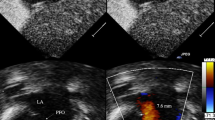Abstract
Redundant foramen ovale (RFO) is defined as an abnormally redundant foramen ovale flap that extends at least halfway across the left atrium. The exact pathogenesis is unknown. Premature, isolated, in utero RFO is rare. The prevalence in general population is unknown as it may be easily ignored on routine fetal echocardiography. The reported frequency in fetuses referred for echocardiographic examination is 0.6–1.7%. It can cause right ventricular volume overload leading to fetal hydrops and subsequent cardiac failure. In such cases, prompt delivery depending on fetal gestational age may be instrumental for the survival of the neonate. 67% can develop cardiac arrhythmias which generally resolves at birth. The most common is premature atrial contractions though rarely, supraventricular tachycardia can also occur. RFO usually occurs in isolation but when associated with congenital heart disease, it carries a poor prognosis. Several series have reported redundant foramen ovale in echocardiographic and autopsy findings in children and adults but only few reports on the antenatal detection of isolated RFO has been described. We discuss two prenatal cases of isolated redundant foramen ovale diagnosed in the third trimester. They were followed up two weekly without development of any complications and delivered at term. After delivery, the infants had no history or symptoms of cardiac distress. Echocardiography showed a structurally normal heart. Hence, if there are no associated anomalies in a case of redundant foramen ovale, the prenatal management need not be altered.




Similar content being viewed by others
References
Hagen A, Albig M, Schmitz L, Hopp H, van Baalen A, Becker R, et al. Prenatal diagnosis of isolated foramen ovale obstruction: a report of 2 cases. Fetal Diagn Ther. 2005;20:7073.
Stewart PA, Wladimiroff JW. Fetal atrial arrhythmias associated with redundancy/aneurysm of the foramen ovale. J Clin Ultrasound. 1988;16:643–50.
Toro L, Weintraub RG, Shiota T, Sahn D, Sahn C, McDonald RW, et al. Relation between persistent atrial arrhythmias and redundant septum primum flap (atrial septal aneurysm) in fetuses. Am J Cardiol. 1994;73(9):711–3.
Rana BS, Thomas MR, Calvert PA, et al. Echocardiographic evaluation of patent foramen ovale prior to device closure. J Am Coll Cardiol Cardiovasc Imaging. 2010;3(7):749–60.
Lev M, Rimoldi HJ, Licata RH, Gasul BM. Premature narrowing or closure of the foramen ovale. Am Heart J. 1963;65(5):638–47.
Abu-Rustum RS, Abi-Nader KN, Zaghloul M, Daou L. Prenatal diagnosis of restrictive foramen ovale: a case report. www.NeonatologyToday.net; 2014 June 6; 9(6).
Hansmann M, Redel DA. Prenatal symptoms and clinical management of heart disease. In: 1er symposium international d’echographie foetale, Starsbourg, France; 1982:137–49.
Rice MJ, McDonald RW, Pilu GG. Cardiac malformations. In: Nyberg DA, editor. Diagnostic imaging of fetal anomalies. Philadelphia: Lippincott Williams & Wilkins; 2003. p. 451–506.
Papa M, Fragasso G, Camesasca C, Di RT, Spagnolo D, Valsecchi L, et al. Prevalence and prognosis of atrial septal aneurysm in high risk fetuses without structural heart defects. Ital Heart J Off J Ital Fed Cardiol. 2002;3(5):318–21.
Hanley PC, Tajik AJ, Hynes JK, et al. Diagnosis and classification of atrial septal aneurysm by two-dimensional echocardiography: report of 80 consecutive cases. J Am Coll Cardiol. 1985;6(6):1370–82.
Sun HY, Fripp RR, Printz BF. Unusual consequence of a fetal atrial septal aneurysm. Clin Case Rep. 2015;3(6):368–9.
Fernández Pineda L, Maître Azcárate MJ, et al. Redundancy of the interatrial septum without associated congenital cardiopathy—its prenatal echocardiographic diagnosis and follow-up. Rev Esp Cardiol. 1995;48(8):537–41.
Dellinger EH. Pathogenesis: unknown [Internet]. Tennessee: TheFetus.net; 1993 [Cited 19 November 2017]. https://sonoworld.com/Fetus/page.aspx?id=36.
Author information
Authors and Affiliations
Corresponding author
Rights and permissions
About this article
Cite this article
Devadasan, S., Batra, M., Balakrishnan, B. et al. Prenatal Diagnosis of Isolated Redundant Foramen Ovale: A Case Report. J. Fetal Med. 5, 159–162 (2018). https://doi.org/10.1007/s40556-018-0169-z
Received:
Accepted:
Published:
Issue Date:
DOI: https://doi.org/10.1007/s40556-018-0169-z



